Mandarin Oranges are a delightful addition to any home garden. Not only do they provide a burst of refreshing flavor, but their vibrant orange color adds a touch of beauty to your outdoor space. Whether you have a spacious backyard or limited gardening space, Mandarin Oranges can be grown successfully in various settings.
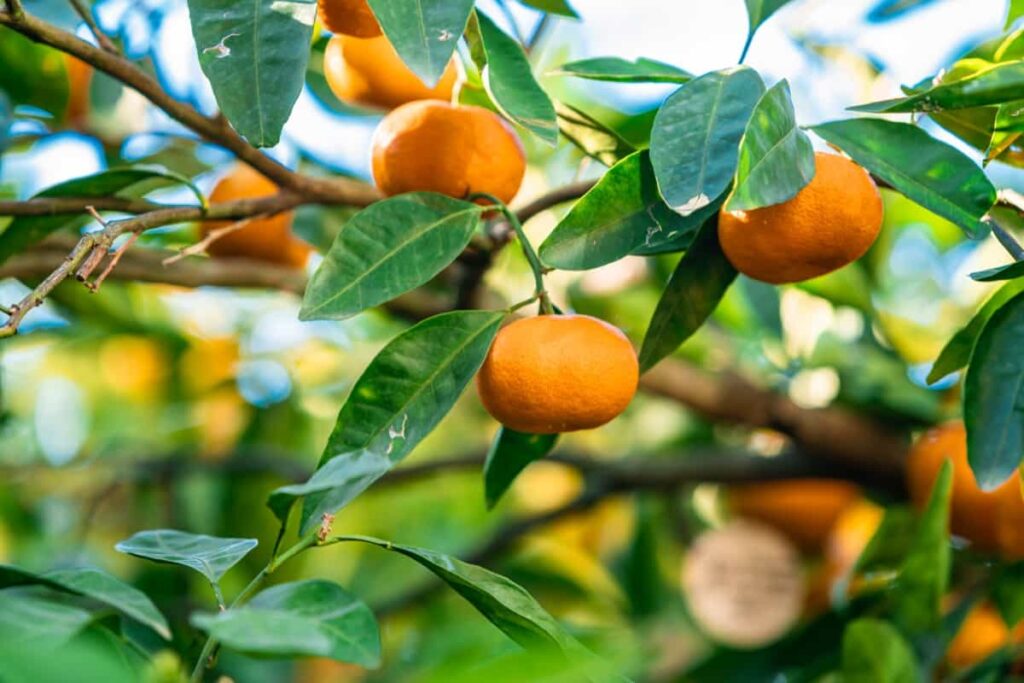
20 Steps to Grow Mandarin Oranges in Season from Seeds
Selecting High-Quality Mandarin Orange Seeds for Optimal Growth
When growing Mandarin Oranges, selecting high-quality seeds is crucial for optimal growth and a bountiful harvest. Look for reputable seed suppliers or nurseries that specialize in citrus fruits. They are more likely to offer quality seeds that are carefully selected and stored under proper conditions. Next, consider the variety of Mandarin Oranges you want to grow. Several popular cultivars, such as Satsuma, Clementine, and Tangerine. Each has a unique flavor profile and growth characteristics, so choose one that suits your preferences and growing conditions.
It’s also important to consider whether you want to grow organic Mandarin Oranges. If so, ensure your selected seeds are from organically grown parent trees. Consider buying certified disease-free or pest-resistant Mandarin Orange seeds to minimize potential problems. Remember that selecting high-quality Mandarin Orange seeds sets the foundation for successful cultivation and a thriving orchard.
Preparing the Potting Mix for Indoor Mandarin Orange Cultivation
Preparing the potting mix is crucial in ensuring successful indoor Mandarin Orange cultivation. The right mix provides the necessary nutrients and drainage for healthy plant growth. Start by selecting a well-draining potting mix specifically formulated for citrus plants. These mixes usually contain a blend of peat moss, vermiculite, perlite, and organic matter. Remember always to use clean containers when preparing your potting mix. Dirty pots may harbor pests or diseases that can harm your Mandarin Orange tree.
Preparing the Soil for Mandarin Orange Seed Planting: Essential Steps
Preparing the soil is crucial in ensuring the successful growth of Mandarin Orange seeds. Clear any debris or weeds from the area to create a clean planting bed. Next, test the soil pH to determine if it is suitable for growing Mandarin Oranges from seeds, which prefer slightly acidic soil with a pH range of 5.5-7.
Providing Adequate Sunlight for Mandarin Orange Seedlings
Sunlight is a crucial element in the growth and development of Mandarin Orange seedlings. These small plants thrive when exposed to direct sunlight for several hours daily. To ensure optimal sunlight conditions, place your Mandarin Orange seedlings in an area that receives at least 6-8 hours daily. This can be achieved by positioning them near south-facing windows or outdoors in a sunny spot.
In case you missed it: Optimizing Sweet Orange Orchard Management: A Month-By-Month Operation Guide for Maximum Yield

If you’re growing Mandarin Oranges indoors, supplement natural light with artificial grow lights to provide adequate illumination. LED grow lights are highly recommended as they emit the full spectrum of light required for healthy plant growth.
Creating the Temperature and Humidity Conditions for Mandarin Orange Growth
Mandarin Orange trees prefer temperatures between 13°C and 29°C. They can tolerate lower temperatures but may suffer damage if exposed to frost or extreme cold. Maintaining a consistent temperature range within this ideal window ensures optimal growth. Humidity is another important factor to consider. Mandarin Oranges thrive in high humidity levels ranging from 50% to 70%.
Growing Mandarin Oranges Indoors
You can grow your Mandarin Orange trees indoors with a little time and effort. To start growing Mandarin Oranges indoors, the first step is to choose the right pot for your tree. Ensure it has good drainage holes and is large enough for the roots to spread out comfortably. Next, transplant your seedlings into these pots using a well-draining potting mix.
Once your Mandarin Orange trees are settled in their new homes, providing them with adequate sunlight is important. These citrus fruits thrive in bright light conditions, so place them near a sunny window or use grow lights if needed. Fertilize your indoor Mandarin Oranges regularly using a balanced citrus fertilizer according to package instructions. This will supply essential nutrients for optimal growth and fruit production.
Choosing the Right Pot for Growing Mandarin Orange Trees
Choosing the right pot for growing Mandarin Orange trees is crucial in ensuring their optimal growth and development. It’s important to choose a large pot to accommodate the root system of your Mandarin Orange tree. A pot that is too small can restrict root growth and lead to stunted development. Look for pots with a diameter of at least 18 inches or more to allow ample space for the roots to spread out.
Transplanting Mandarin Orange Seedlings into Pots
Before transplanting, ensure you have chosen the right pot size for your Mandarin Orange seedling. A pot that is too small can restrict root development, while a pot that is too large may lead to overwatering or waterlogged soil. Remove the seedling from its current container or nursery tray, not damaging the delicate roots.
Place the seedling in the center of the new pot, ensuring that it sits at the same depth as before. Fill in any gaps around the plant roots with fresh potting mix, pressing down gently to secure the seedling in place. Water thoroughly after transplanting to help settle the soil and provide much-needed hydration.
Growing Seedless Mandarin Oranges
It can be a rewarding experience for citrus enthusiasts. These delicious and easy-to-peel fruits are popular for those who prefer a sweeter and more convenient option. It’s important to select the right variety of Mandarin Orange that is known for its seedlessness. Popular options include Satsuma, Clementine, and Honey Murcott. Once you have chosen your desired variety, it’s time to prepare the soil or potting mix.
In case you missed it: How to Start Sweet Potato Farming in Asia: A Guide of Cultivation for Beginners
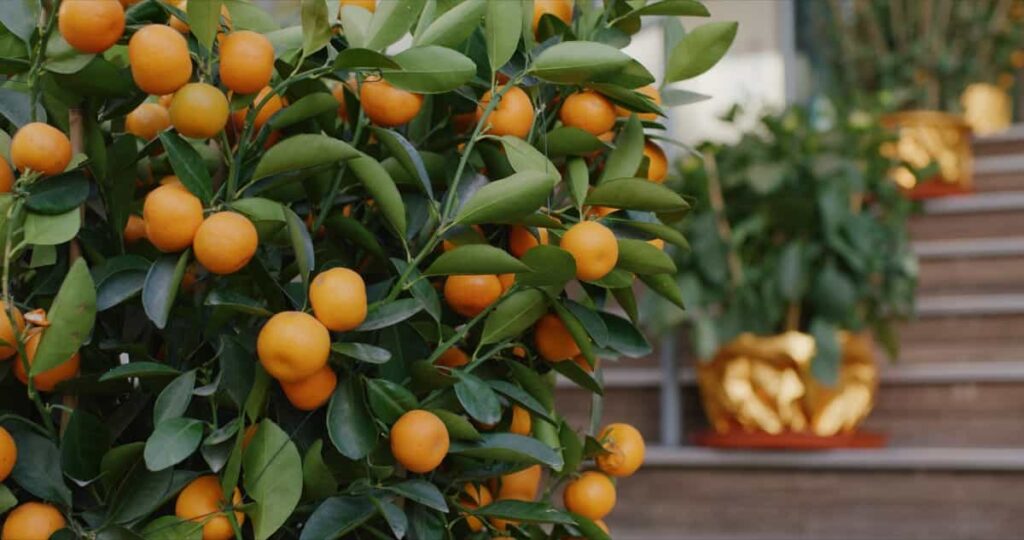
Watering Mandarin Orange Seeds: Dos and Don’ts
Dos:
- Water consistently: Mandarin Orange seeds need regular moisture, so water them consistently. Aim to keep the soil moist but not soggy.
- Use room temperature water: Avoid cold or hot water, as extreme temperatures can shock the delicate seedlings. Opt for room-temperature water instead.
Don’ts:
- Overwater: While consistent moisture is important, overwatering can harm Mandarin Orange seeds. Avoid letting the soil become overly saturated, which can suffocate the plant roots and cause fungal diseases.
- Underwater: On the other hand, underwatering can result in stunted growth and drying out of seedlings. Monitor soil moisture levels regularly and adjust your watering accordingly.
Providing Proper Drainage in Potted Mandarin Orange Trees
One crucial factor in successfully growing Mandarin Orange trees in pots is ensuring proper drainage. Adequate drainage is essential to prevent waterlogged soil, which can lead to diseases. When watering your potted Mandarin Orange tree, don’t overwater it. It’s better to be underwater than overwater, as excessive moisture can cause root problems.
Managing Watering and Fertilization in Potted Mandarin Oranges
These citrus trees require consistent moisture levels to thrive, but overwatering the plant can lead to root rot and other issues. It’s important to strike a balance. When watering your potted Mandarin Orange tree, you should aim for moist but not soggy soil. Be sure to provide enough water to reach the entire root ball.
Regarding fertilization, Mandarin Orange trees benefit from regular feeding during the growing season. Use a balanced fertilizer for citrus trees and follow the package instructions for application rates. Typically, you’ll want to fertilize every 2-3 months during spring and summer.
Overwintering Mandarin Orange Trees in Pots: Key Considerations
As the cold weather approaches, you must consider certain considerations to ensure the survival and thriving of your potted Mandarin Orange trees. Before the frost sets in, bring your potted Mandarin Orange tree indoors. This will protect it from extreme temperatures and harsh winds. Find a suitable location with enough sunlight exposure for optimal growth.
In case you missed it: Best Practices to Grow Sweet Potatoes at Home: Check How this Guide Helps Beginners
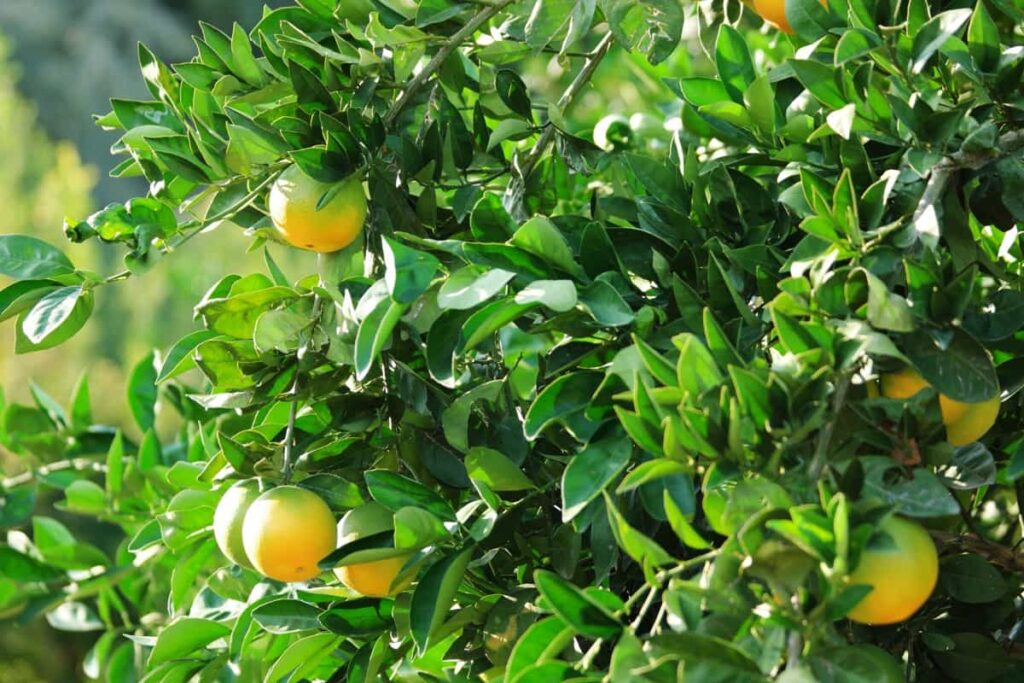
During winter months, watering requirements change significantly. It is essential to reduce the frequency of watering while still ensuring that the soil remains slightly moist. Maintaining proper humidity levels indoors is also important during winter. You can use a humidifier or place a tray filled with water near the plant to increase humidity.
Troubleshooting Common Issues in Growing Mandarin Oranges from Seeds
Weak Seedlings: Weak seedlings may indicate insufficient light or nutrient deficiencies. Ensure they receive adequate sunlight or use grow lights if growing indoors. Consider using a balanced fertilizer formulated for citrus trees to provide essential nutrients.
Yellowing Leaves: Yellow leaves in Mandarin Orange trees can indicate overwatering, nutrient deficiency (such as iron), or pests like aphids or mites. Adjust watering practices, fertilize as needed, and inspect leaves for signs of infestation.
Leaf Drop: Excessive leaf drop could result from stress factors like overwatering, underwatering, temperature fluctuations, or inadequate humidity levels. Maintain consistent watering habits and create a stable environment with appropriate temperature and humidity conditions.
Pest Infestations: Aphids, spider mites, and citrus leaf miners are common pests that affect Mandarin Oranges. Try using organic pest control ways such as neem oil spray or insecticidal soap to combat these invaders.
Fertilizing Mandarin Orange Seedlings: Best Practices
Proper fertilization ensures Mandarin Orange seedlings’ healthy growth and development. Choose a balanced fertilizer specifically formulated for citrus plants. Look for one with a ratio of nitrogen (N), phosphorus (P), and potassium (K) that is suitable for fruit-bearing trees. Start feeding your Mandarin Orange seedlings about six weeks after planting them in their pots or on the ground. Continue regular feedings every four to six weeks during the growing season.
Pruning and Training Mandarin Orange Trees for Optimal Shape and Yield
To begin tree pruning, start by removing any dead or damaged branches. This will improve the tree’s overall appearance and prevent the spread of diseases. Next, thin out crowded branches to allow better air circulation and light penetration. By properly pruning your Mandarin Orange trees, you can control their size and shape, making them more manageable in a confined area.
Consider using support structures such as trellises or stakes when training your Mandarin Orange tree. These will help guide the tree’s growth in the desired direction and prevent branches from bending or breaking under heavy fruit loads. Regularly trimming back excessive growth throughout the year is important to maintain an open canopy structure. Proper pruning techniques are crucial for maintaining a healthy Mandarin Orange tree with excellent shape and abundant yields.
Protecting Mandarin Orange Trees from Pests and Diseases
Keeping your Mandarin Orange trees healthy and free from pests and diseases is important for a successful harvest. These beautiful citrus trees are susceptible to various insects, fungi, and viruses that can hinder their growth and fruit production. However, you can effectively protect your Mandarin Orange trees with proper care and preventive measures.
The citrus leaf miner is among the most common pests affecting Mandarin Oranges. To prevent infestations, regularly inspect your tree’s leaves for signs of damage or silvery trails left by these pests. If detected early, prune affected branches or use insecticidal soap to control their population.
In case you missed it: 15 Best Apple Tree Fertilizers: Liquid and Organic Nutrients for Healthy Fruit Yield
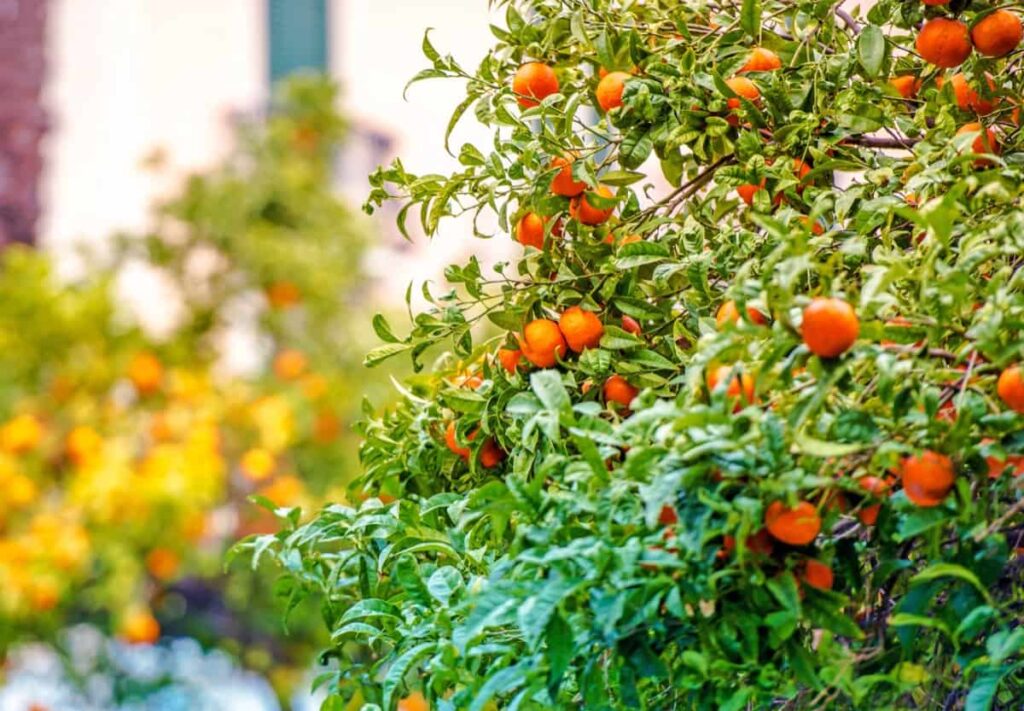
Another pest to watch out for is aphids. These small insects suck sap from new growth, causing leaf deformities and stunting overall tree development. Encourage natural predators like ladybugs or lacewings that feed on aphids or use organic insecticides specifically formulated for citrus trees. Fungal diseases can also affect Mandarin Oranges in humid conditions. To prevent this disease, ensure good air circulation around your tree by pruning dense branches regularly. Apply fungicides labeled safe for citrus when necessary.
Harvesting Mandarin Oranges: When and How to Pick the Fruit
The best way to determine if a Mandarin Orange is ready for harvest is by color. The fruit should have turned a vibrant shade of Orange, indicating that it has reached maturity. Additionally, the skin should feel smooth and easy to peel. To pick the fruit, gently twist or pull it from the branch.
Be careful not to damage any surrounding branches or leaves in the process. If the fruit doesn’t come off easily, it may not be ripe yet, so give it more time on the tree. Once harvested, Mandarin Oranges can be enjoyed immediately or stored for later use. They can last up to two weeks at room temperature or several months if refrigerated.
Storing and Preserving Mandarin Oranges for Longevity
- Choose ripe, firm Mandarins: Select vibrant Orange fruits with no soft spots or bruises.
- Store in a cool place: Keep your Mandarins in a cool area away from direct sunlight, such as a pantry or cellar.
- Do not wash before storing: It’s best to leave the fruit unwashed until just before consuming it to prevent premature spoilage.
- Check regularly for spoilage: Inspect your stored Mandarins frequently and discard those that show signs of decay or mold.
Best Season to Grow Mandarin Oranges
The best season to grow Mandarin Oranges is in the early spring, as this gives them ample time to establish themselves before facing the cold winter temperatures. By planting Mandarin Orange seeds in the early spring, you allow them to take advantage of the longer days and increasing sunlight that comes with this time of year.
Mandarin Oranges Yield Per Tree
If you’re considering growing these delicious fruits, it’s important to understand the yield per tree and the time it takes for them to reach their full bearing potential. On average, a mature Mandarin Orange tree can produce 500-800 fruits in a single season. However, it’s worth noting that this level of productivity is typically achieved after approximately 9-10 years of growth. Only when they reach the age of 10-12 years do these trees enter their full bearing stage.
Mandarin Oranges Yield Per Acre
Mandarin Oranges are not only delicious and nutritious, but they also have the potential to yield a bountiful harvest. If you’re wondering about the average yield of Mandarin Oranges per acre, you’ll be pleased to know that it can reach an impressive 4.8 tonnes.
In case you missed it: Tangerine vs. Orange: Know the Key Differences
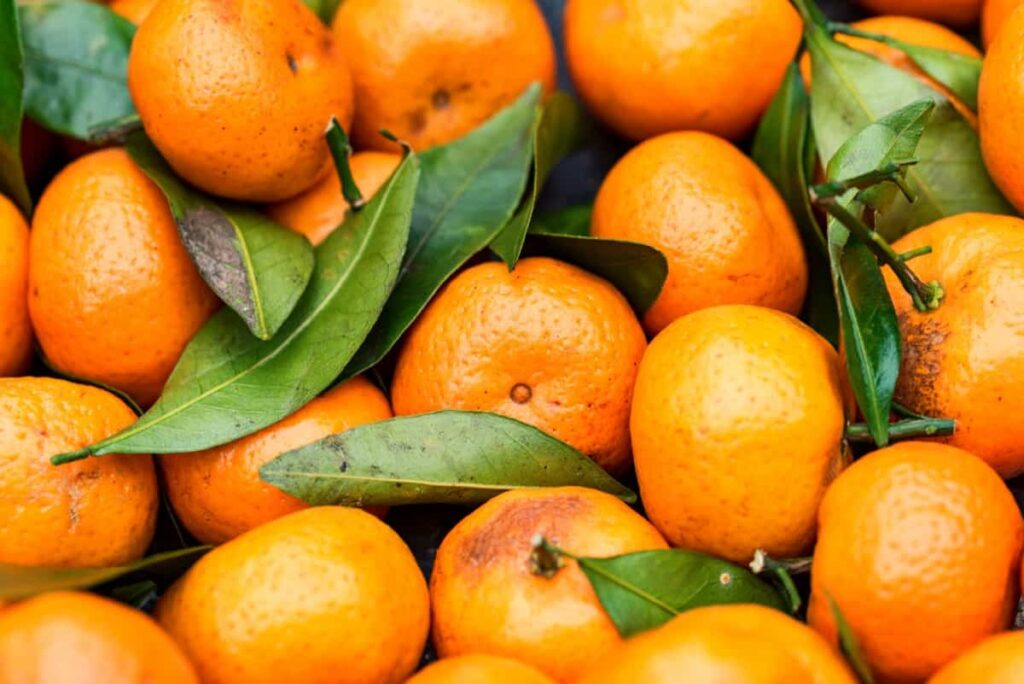
Growing Mandarin Oranges Table
| Steps for Growing Mandarin Oranges | Conditions |
| Select high-quality seeds | Choose seeds from healthy and disease-free fruits. |
| Prepare potting mix | Create a well-draining mixture of organic soil, sand, and compost. |
| Prepare the soil | Soil is fertile with good drainage. |
| Provide adequate sunlight | Get at least 6-8 hours of direct sunlight each day. |
| Control temperature | Maintain temperatures between 15-29°C. |
| Grow indoors if needed | Grown indoors using grow lights to supplement natural light. |
| Choose the right pot size | Select pots that are deep to accommodate root growth. |
| Proper watering techniques | Water regularly, but avoid overwatering. |
| Prune and shape potted trees | Remove dead or diseased branches. |
| Store Mandarin Oranges | Store Oranges in a cool place to extend their shelf life. |
Conclusion
With their vibrant color and sweet, juicy flesh, Mandarin Oranges are a delicious treat with health benefits. These small citrus fruits are rich in essential minerals that can promote overall well-being. Selecting high-quality seeds for optimal growth is essential for growing Mandarin Orange trees. Look for seeds from reputable suppliers or consider using the seeds extracted directly from ripe fruits.
- Management Pests and Diseases in Your Cotton Field
- Sheep Farming Business Plan for Beginners
- Aquaponic Farming at Home: A Step-By-Step Guide
- Profitable Village Farming Business Ideas in 2024
- High-Yield Aquaculture: Fast-Growing Fish for Farming
- Effective Fish Pond Construction Techniques for Beginners
- Irrigation and Water Management in Pineapple Farming
- Blossom to Harvest: Mastering Flowering and Pollination in Papaya Farming
- Pig Fattening Essentials: From Selection to Sale for Beginners
- Raising Wagyu Cattle: A Complete Guide for Premium Beef Production
- Soil Types and Their Water Holding Capacity
- Optimizing Irrigation Schedules for Coconut Groves for Enhanced Yield
- Espresso Your Garden: Coffee Grounds for Healthier Acid-Loving Plants
- The Best Soil Mix for Snake Plants: How to Mix Your Own Snake Plant Soil
- Green Thumb Success: Expert Tips for Cultivating Greenhouse Beans All Year Round
- Bloom All Year Round: The Ultimate Guide to Indoor Hyacinth Care
- Eco-Friendly Gardening: How to Make Liquid Fertilizer from Kitchen Waste
- Ultimate Guide to Grow Anise in Pots: Explore Seed Propagation to Harvesting
- Guide to Raising Chester White Pigs: Discover Breed Facts to Growth Management
- Mastering the Elegance: The Ultimate Guide to Weeping Cherry Tree Care, Planting, and Maintenance
- Ultimate Guide to Planting Garlic in Grow Bags: Growing Strategies for Beginners
- How to Fix Spider Plant Leaf-Related Problems: Natural and Organic Remedies
- 10 Reasons Why Your Tulsi Plant is Shedding Leaves: Home Remedies and Solutions
- Optimizing Growth and Yield: The Advantages of Palm Bunch Ash Fertilizer
- Utilizing Neem Oil Extract as a Natural Pesticide for Hydrangea
- From Soil to Harvest: Various Ways in Which Farmers Can Use AI Tools
- Steps to Encourage and Induce Citrus Flowers: A Comprehensive Guide
- How to Fix Snake Plant Leaf-Related Issues: Natural and Organic Remedies
- Transform Your Garden into a Fragrant Oasis with Raat Ki Rani (Night Blooming Jasmine)
- Discover the Ideal Chicken Breeds for Philippine Farms
- How to Create a Poultry Egg Farm Business Plan for Profits
- Grow Lemon Cucumbers Like a Pro: Insider Techniques for Bountiful Yields
- Ultimate Guide to Caring for Your Pink Princess Philodendron: Tips for Thriving Variegation
- Areca Nut Profit Per Acre: Calculating Yield and Cost of Cultivation
- How Kaveri Chicken is Becoming a More Profitable Breed in Indian Backyards
- Transform Your Barn: 9 Steps to Convert a Horse Stall into a Chicken Coop
